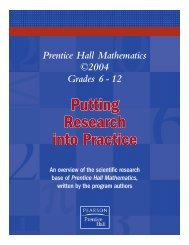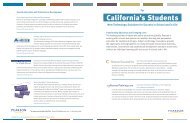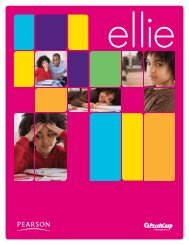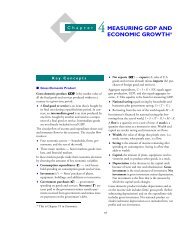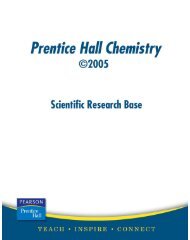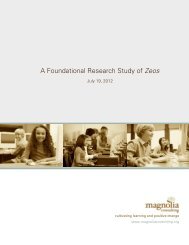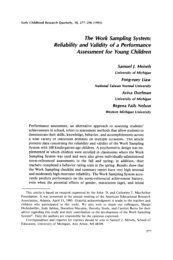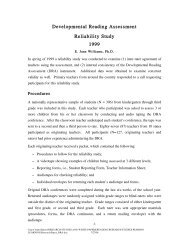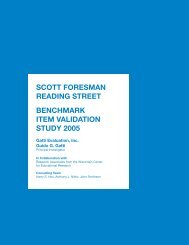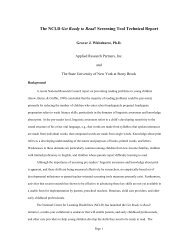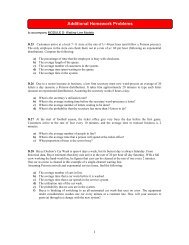Pearson Successmaker Math Efficacy Study 2009-10 Final Report
Pearson Successmaker Math Efficacy Study 2009-10 Final Report
Pearson Successmaker Math Efficacy Study 2009-10 Final Report
You also want an ePaper? Increase the reach of your titles
YUMPU automatically turns print PDFs into web optimized ePapers that Google loves.
SuccessMaker <strong>Math</strong> RCT Gatti Evaluation Inc. 9-15-<strong>10</strong>The district adopted a widely published elementary basal mathematics curriculum with a latecopyright date. One of the 3 rd grade teachers adhered strictly to the district adopted curriculumand the other reported using some supplementation, as did the 7 th grade teacher. The teachersincorporated district learning standards and AIMS (Arizona's Instrument to Measure Standards)test preparatory work into their daily mathematics lessons, as well as some speed drills.Teachers had used this same basal program for 2 years, however, one of the 3 rd grade teachershad just begun her second year. Teachers in this school have daily math blocks of one hour. Thestudy teachers prefer using a combination of skills- and activity-based teaching styles for mathinstruction and have no additional assistance in the classroom. They conduct their math lessonsusing whole group instruction 50% or more of the time. Also, the 3 rd grade teachers like toexplore educational websites on their interactive white boards.The school has a large computer lab that is housed in the library. Stations are arranged in longrows, facing the same direction. This computer lab is where students used the SuccessMakerprogram. SuccessMaker students in 3 rd and 5 th grades used the program in addition to theirregular math block, while 7 th grade students used SuccessMaker during their daily math block.Those teachers randomly assigned to use the SuccessMaker <strong>Math</strong> program were trained the weekprior to the start of the school year. These teachers also received additional trainings inNovember and February. Students completed baseline testing the last week of September andwere tested again the week of April 30 th . Students’ last week using the program was the lastweek of April.One 3 rd grade teacher used the SuccessMaker program in 25 minute sessions three times perweek, while the other used the program for 35 minute sessions, also three times per week. Themedian 3 rd grade student used the math program approximately 18 hours, attempting 43 exercisesevery thirty minutes with a success rate of 66%. In 7 th grade, SuccessMaker usage variedthroughout the year. While the minimum usage time was not met during the first half of the year,the 7 th grade teacher tried to get in at least 75 minutes per week in two separate sessions duringthe spring term. The median 7 th grade student used the math program approximately 12 hours,attempting 34 exercises every thirty minutes with a success rate of 61%.Arizona District TwoTwo schools in the second Arizona district participated in the study. Both schools reside in asuburban area. In 2008-09 the district served a community of over 70,000. The medianhousehold income is approximately $65,000 indicating a high-middle class community. Despitethis income statistic, many students at these Title 1 schools come from low-income areas, with ahigh population of Hispanic students and English language learners. Teachers report having awide range of learning abilities in their classes, and that getting students interested in classroommaterial is a big challenge. Both schools enforce a strict dress code for their students. Thedistrict adopted two widely published elementary basal mathematics curricula with a latecopyright date, one for elementary grades and another for middle grades.The first school in Arizona is a large size school serving over 1,<strong>10</strong>0 students in gradeskindergarten through eight. The school has one primary ethnic group, Hispanic, making up atotal of 83% of the school population. This school falls into the high range for participation inthe nation’s free or reduced-price lunch program with 87% of students eligible to receive free orreduced-price lunch. Approximately 41% of the students are designated as not Englishproficient. The student/teacher ratio is approximately 19 to 1.- 19 -



